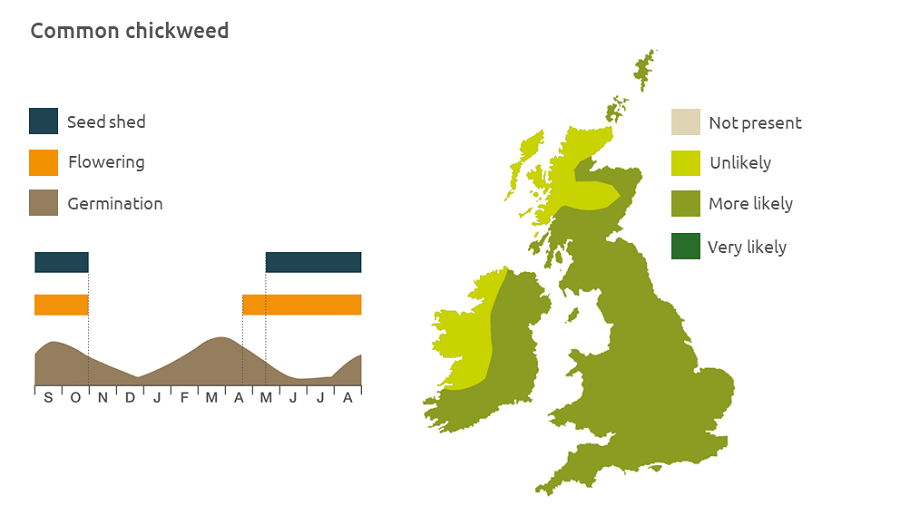- Home
- Knowledge library
- Distribution and biology of common chickweed in the UK
Distribution and biology of common chickweed in the UK
Common chickweed is a broad-leaved weed that can be seen flowering at any time of year. Find out how to identify and control it.
Overview
Common chickweed (Stellaria media) can grow at relatively low temperatures and may suppress overwintered crops or, if dense, severely restrict crop growth. Germination of chickweed can occur throughout the year, with up to three generations possible in any one year in winter cereals, particularly wheat; plants may be seen to be flowering at any time. Spring-germinating plants die in late summer, while autumn-germinating plants survive the winter as a dense low-growing mat. Plants may reproduce by seed, moved by birds, or vegetatively by root cuttings.
- It is particularly competitive in winter oilseed rape and spring crops
- Some populations are associated with herbicide resistance
- It has value to biodiversity
Weed Resistance Action Group (WRAG)
Description
It is an annual low-growing bright-green plant, with tiny five-petalled white flowers.
Key features
Plant: The stems are rounded with a single line of hairs.
Leaves: The leaves are oval, usually 8 mm or longer, and end in a slight point.
Lookalikes
Common chickweed may be confused with common mouse-ear.

Location and life cycle

Geographic distribution
Common chickweed can be found all over Britain, especially in crops, usually below an altitude of 200 m but able to grow up to 400 m.
Soil type
It grows on fertile nitrogen-rich soils which are not highly acid. It prefers watered but not waterlogged situations.
Seed statistics
- Seed longevity: >5 years
- Germination depth: 3.6 cm
- Seed weight: 0.35 mg
- Seeds/flower: 8
- Seeds/plant: 2,500
Management
Control by preventing seed production and re-establishment after cultivation. Early shallow tillage encourages the seed germination; when the seedlings emerge, the land should be tilled again and then drilled with the crop.
For advice on herbicides, please speak with your agronomist or adviser.
Herbicide resistance
Over 50 UK ALS-resistant chickweed populations have been identified (2016), with a wide geographic spread – across 13 counties of England, Northern Ireland and Scotland.
ALS herbicides inhibit acetolactate synthase (HRAC MOA Classification Group 2) in weeds.
In UK populations, two ALS target-site mutations have been identified:
- Pro-197-Gln – associated with resistance to the sulfonylurea, metsulfuron-methyl
- Trp-574-Leu – associated with resistance to the sulfonylurea, metsulfuron-methyl and the triazolopyrimidine, florasulam
If resistance is confirmed, use alternative (non-ALS) herbicides.
Although resistance to mecoprop (also HRAC MOA Classification Group 4) has been detected in UK chickweed (1985), with inadequate control reported in Scotland and Ireland, all samples of ALS-resistant chickweed screened by Rothamsted Research (2016) were well controlled by this herbicide.
The results of regular herbicide resistance tests (on seeds or plants) provide a strong indication of the unique resistance profiles present across each field.
- Collect seeds in June, July and August
- Check plants for flowers and seedpods (seedpods will always be green)
- Pull up/cut at the plant base large quantities of weed and place in a large paper sack – do not pack too tightly but allow enough room for air to circulate
- Place the open sack in a well-ventilated area where the plants can dry out; as they dry, seeds will fall from the heads to the bottom of the sack
- When dry, remove the chickweed straw, shaking any loose seeds into the sack
- When the straw has been removed, tip the seeds into an envelope
How to detect herbicide resistance in arable weeds
When was this information last updated?
This page is based on content from the encyclopaedia of arable weeds publication. Since it was first released in 2008, the publication has been redesigned several times but not revised. However, it remains a good foundation for general information on the distribution and biology of weeds.

